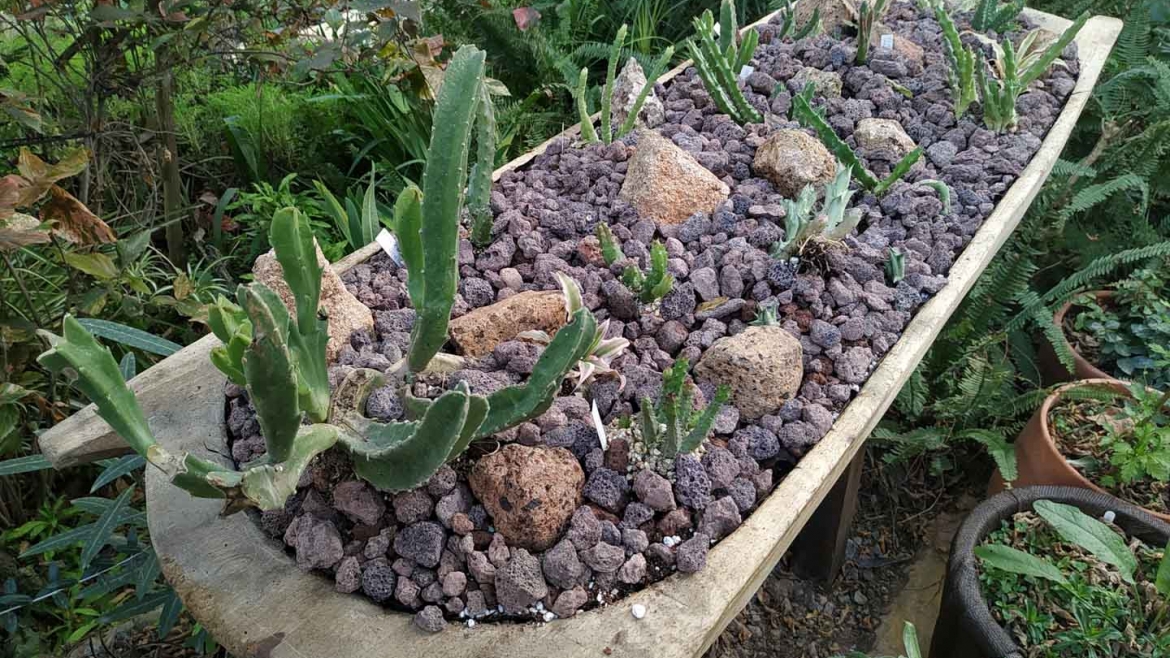Since the Garden began in 2000, efforts have been made to increase the number of existing species in it. Following a scientific criterion, the plants have been located in those places that meet the conditions that they need, it is therefore that we find ornamental, fruit, exotic and native plants living together. Although we are in the same place, each space has different environmental conditions, therefore, it is the plants that determine the design of the Garden.
The main objective is to achieve a great diversity of plant species, since the climate of Almería allows plants to be grown in warm areas that can hardly be found in another part of Europe. These collections are enriched with native plants typical of our environment and with specific projects developed in threatened or endangered flora.
List Of Plants
PALMS:
Palm trees are monocotyledonous plants, which are characterized by having a single embryonic leaf in their seeds. There are more than 2,800 species spread over the five continents.
The collection of palm trees in La Almunya del Sur has 11 species.
INSECTIVORES, ORCHIDS AND BROMELIAS:
In a small greenhouse and in the garden itself there are three collections of plants:
– Orchids: they are perennial herbaceous plants, highly evolved and with specialized flowers in relation to their pollinators. There are more than 25,000 species and they live on almost every continent. Some species are terrestrial and others are epiphytes. In this space you can see species of the genera, Phalaenopsis, Epidendrum, Oncidium, Cymbidium, Vanilla, etc.
– Bromeliads: most are herbaceous plants with short stems, with a rosette of rigid leaves with a colored underside. Water collects at the base of the leaves and is taken up by the plant through adventitious roots or specialized absorbent hairs. Some genera such as Tillandsia are entirely epiphytes, that is, they live on other plants without parasitizing them. There are several representatives of them, as well as other genera such as Cryptanthus, Aechmea and Guzmania.
– Insectivorous: they are plants that live in humid environments, such as peat bogs and swampy areas, which are poor in nutrients. Their most unique characteristic is that they present an adaptive response that consists of the modification of their leaves to capture their prey. Among the group of species are represented the genera Nepenthes, Drosera, Sarracenia and Dionaea.
INSECTÍVORAS, ORQUÍDEAS Y BROMELIAS:
En un pequeño invernadero y en el propio jardín conviven tres colecciones de plantas:
AQUATIC:
The aquatic plants are distributed in the different aquatic spaces that the Garden has. Among them there are those that live submerged in water, such as filamentous green algae.
Floating plants of the genus Nymphaea, Azolla, Lenna, Salvinia, etc. And marsh plants of the genera Thypha, Phragmites, Pontderia, Tamarix, Cyperus, Zantedeschias, Iris, etc.
PRIMITIVE PLANTS:
250 million years ago, plants first began to produce pollen and seeds, which helped them reproduce better. These first plants with seeds were Gymnosperms, plants that have survived on the planet ever since.
In the garden we can see Ginkgo biloba, Cyca revoluta and Zamia pumila
And within the marsh and prehistoric plants is the Equisetum hyemale.
BAMBOO:
We can see in the Garden the Imperial Bamboo (Bambusa vulgaris “Vitatta”), other bamboos of the genus Arundinaria, Pseudosasa and Phyllostachys.
FRUIT TREES:
La Almunya del Sur was originally an agricultural estate. Mandarins of the Clemenules variety were mainly grown. These trees were planted in 1969. Today part of them remain as testimony to the former productivity of the farm.
Other fruit trees that share space with mandarins are: plums, orange trees, medlars, pear trees, apple trees, fig trees, etc.
It is worth highlighting the centenary vine of Muscat grape that welcomes the Garden.
CACTUS AND SUCCULENTS:
They are species that, because they live in very arid areas, have specialized tissues to accumulate water in leaves, stem or roots, constituting a water reserve for the long periods of frequent drought in their habitat. Succulents are distributed throughout the tropical and subtropical areas of America and Africa.
This Garden gathers a great wealth of genres and families, as well as shapes, sizes and adaptations to the environment in which they live. The families are Agavaceae, Aizoaceae, Liliaceae, Apocynaceae, Asclepidaceae, Cactaceae, Crassulaceae, Dracaenaceae, Euphorbiaceae, Hyacinthaceae, Portulacaceae, and Vitaceae.
MEDITERRANEAN FLORA:
The climatic characteristics of Almería are mild temperatures almost all year round, very hot summers and little rains. These factors fundamentally affect the distribution of vegetation. The climate also varies with altitude, giving rise to a series of levels with different sets of plant species, known as “bioclimatic floors”. The one that corresponds to this area of Almería is the thermomediterranean floor, which goes from sea level to about 800 m of altitude.
The main characteristics of the flora in it are the result of surviving long periods without water, reducing evaporation to a minimum to avoid water loss. The mechanisms used are diverse, such as small and hard leaves, in some cases transformed into spines; or they can be covered with hairs or protective waxes that retain moisture inside the plant; in addition, the roots are usually woody and deep to better search for water.
The garden has 150 autochthonous species, among which we can see the genera Euphorbia, Viburnum, Drimia, Pancratium, Glaucium, Olea, Asteriscus, Whitania, Maytenus, Caralluma, etc.

